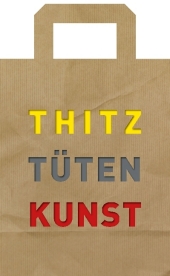 Neuerscheinungen 2016Stand: 2020-02-01 |
Schnellsuche
ISBN/Stichwort/Autor
|
Herderstraße 10
10625 Berlin
Tel.: 030 315 714 16
Fax 030 315 714 14
info@buchspektrum.de |

Thitz
Thitz Tüten Kunst
2016. 245 S. farbige Abbildungen. 28 cm
Verlag/Jahr: PAGINA 2016
ISBN: 3-946509-03-7 (3946509037)
Neue ISBN: 978-3-946509-03-5 (9783946509035)
Preis und Lieferzeit: Bitte klicken
Katalog zu den Tütenbildern des Malers und Zeichners Thitz, der mit diesen Tütenbildern berühmt wurde. Der Katalog ist ein Deckeband mit Fadenheftung und Tragegriff, entsprechend seiner Bilder.
FOLLOW THE LINE ...
OR: HOW TO GET A GRIP ON THE EIFFEL TOWER
A delicate young girl with big blue eyes in an orange dress is holding up the landmark of the French capital in her right hand as if she wanted to juggle with the Eiffel Tower. The tower itself is chock-a-block full of visitors peeking out of all the openings in the steel colossus. This is unusual enough, but there´s more to come: the tip of the tower spins out finely into the delicate handle of a paper bag, as if the tip of the Eiffel Tower doesn´t want to end but mutate into something new.
We are looking at a work by the painter and drawer Thitz, who has gained fame with his bag art. From the very outset, his oeuvre has been inconceivable with the practical paper receptacles. Bags, symbolized by handles, serve as surfaces for painting or as element for collages; printed with writing or images, they are a source of inspiration for the artist and sounding board for his design.
The bag gives Thitz an authentic symbol for his message in his quest for a global visual language reflecting the past and present of mankind on our planet. For a long time, the artist made use of the advertising messages on bags. He exploited and varied them for his own word creations, not infrequently with Dadaist alienation. One of the early explanations still holds good: there are bags throughout the world, from Europe to Asia, from Africa to America. And everywhere in the world they serve the purpose of transporting goods from one place to another, a genuine symbol of a globalized society. Also worldwide is a phenomenon that can assume almost philosophical dimensions: not infrequently, the bag can lose the original unity of external form and content. A small bag whose label promises value can easily contain something completely banal off a supermarket shelf, whereas the banal bag from a discount store may be conveying valuable documents or a treasured diamond ring. Nothing is what it seems to be: a universal insight. For the world of Thitz, the bag is the born motif; it is a symbol of globalization and globalization itself.
For many years, the artist has been mounting a fascinating view of the world with his bags. His pictures have been repeatedly described and placed in the context of historical cityscapes. A close look shows how unequalled his painterly force, his vital narrative language are. Thitz is a marvellous storyteller, but we should not be deceived by the seemingly decorative weave of colourful motifs and narratives. The message of these images, like the bags, is ambivalent. Behind them looms the other, the second level, to be penetrated only by the attentive observer. Over and again, Thitz seeks to build this level into his pictures with the medium of photography.
Like the seemingly determinate object bag, the photograph is an attempt to bring a supposedly objective image into one´s own world. The photos often have the effect of postcards, of greetings from afar collaged into visual messages. Painted over and alienated, they form another narrative level with which the artist plays.
The paintings and collages that constitute the world of Thitz are a homage to the variety and diversity of the world. Wherever Thitz is, his visual language reflects an optimistic view of the world that is very much his own. It is, however, not to be mistaken for a naive answer to the questions of our times. For all the cheerfulness of his figures and buildings we find - not apparent at first glance - the sad eyes, the questioning figures who, isolated in their world, are begrudged a share in globalized consumption. The Fifth Avenue bag perhaps serves the Syrian refugee setting out on his long journey to Europe to carry his last belongings.
The artist translates this ambivalence of our reality directly into his painting. With all the colours, movement, stories, it is easy to overlook that Thitz also works with watercolours.


